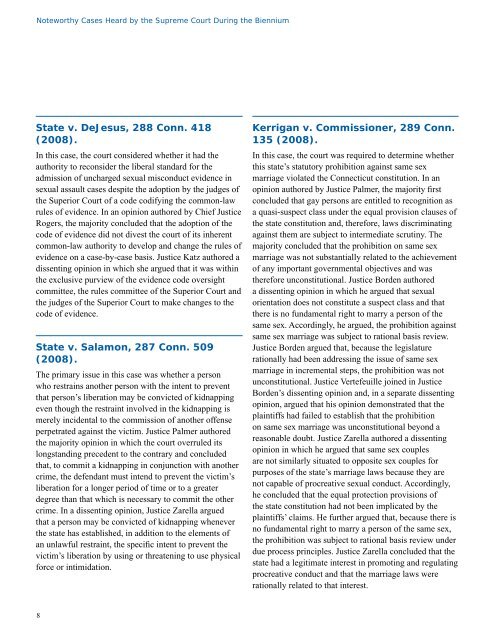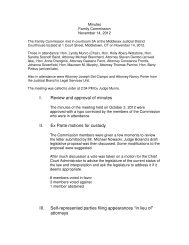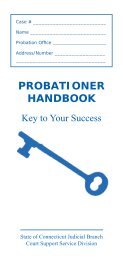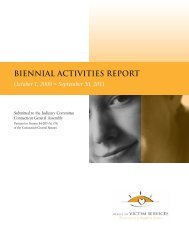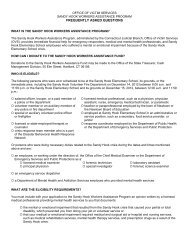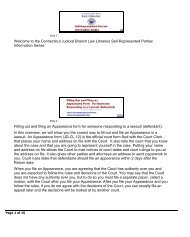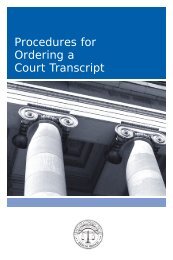Biennial Report, 2008-2010 - Connecticut Judicial Branch - CT.gov
Biennial Report, 2008-2010 - Connecticut Judicial Branch - CT.gov
Biennial Report, 2008-2010 - Connecticut Judicial Branch - CT.gov
Create successful ePaper yourself
Turn your PDF publications into a flip-book with our unique Google optimized e-Paper software.
Noteworthy Cases Heard by the Supreme Court During the Biennium<br />
State v. DeJesus, 288 Conn. 418<br />
(<strong>2008</strong>).<br />
In this case, the court considered whether it had the<br />
authority to reconsider the liberal standard for the<br />
admission of uncharged sexual misconduct evidence in<br />
sexual assault cases despite the adoption by the judges of<br />
the Superior Court of a code codifying the common-law<br />
rules of evidence. In an opinion authored by Chief Justice<br />
Rogers, the majority concluded that the adoption of the<br />
code of evidence did not divest the court of its inherent<br />
common-law authority to develop and change the rules of<br />
evidence on a case-by-case basis. Justice Katz authored a<br />
dissenting opinion in which she argued that it was within<br />
the exclusive purview of the evidence code oversight<br />
committee, the rules committee of the Superior Court and<br />
the judges of the Superior Court to make changes to the<br />
code of evidence.<br />
State v. Salamon, 287 Conn. 509<br />
(<strong>2008</strong>).<br />
The primary issue in this case was whether a person<br />
who restrains another person with the intent to prevent<br />
that person’s liberation may be convicted of kidnapping<br />
even though the restraint involved in the kidnapping is<br />
merely incidental to the commission of another offense<br />
perpetrated against the victim. Justice Palmer authored<br />
the majority opinion in which the court overruled its<br />
longstanding precedent to the contrary and concluded<br />
that, to commit a kidnapping in conjunction with another<br />
crime, the defendant must intend to prevent the victim’s<br />
liberation for a longer period of time or to a greater<br />
degree than that which is necessary to commit the other<br />
crime. In a dissenting opinion, Justice Zarella argued<br />
that a person may be convicted of kidnapping whenever<br />
the state has established, in addition to the elements of<br />
an unlawful restraint, the specific intent to prevent the<br />
victim’s liberation by using or threatening to use physical<br />
force or intimidation.<br />
Kerrigan v. Commissioner, 289 Conn.<br />
135 (<strong>2008</strong>).<br />
In this case, the court was required to determine whether<br />
this state’s statutory prohibition against same sex<br />
marriage violated the <strong>Connecticut</strong> constitution. In an<br />
opinion authored by Justice Palmer, the majority first<br />
concluded that gay persons are entitled to recognition as<br />
a quasi-suspect class under the equal provision clauses of<br />
the state constitution and, therefore, laws discriminating<br />
against them are subject to intermediate scrutiny. The<br />
majority concluded that the prohibition on same sex<br />
marriage was not substantially related to the achievement<br />
of any important <strong>gov</strong>ernmental objectives and was<br />
therefore unconstitutional. Justice Borden authored<br />
a dissenting opinion in which he argued that sexual<br />
orientation does not constitute a suspect class and that<br />
there is no fundamental right to marry a person of the<br />
same sex. Accordingly, he argued, the prohibition against<br />
same sex marriage was subject to rational basis review.<br />
Justice Borden argued that, because the legislature<br />
rationally had been addressing the issue of same sex<br />
marriage in incremental steps, the prohibition was not<br />
unconstitutional. Justice Vertefeuille joined in Justice<br />
Borden’s dissenting opinion and, in a separate dissenting<br />
opinion, argued that his opinion demonstrated that the<br />
plaintiffs had failed to establish that the prohibition<br />
on same sex marriage was unconstitutional beyond a<br />
reasonable doubt. Justice Zarella authored a dissenting<br />
opinion in which he argued that same sex couples<br />
are not similarly situated to opposite sex couples for<br />
purposes of the state’s marriage laws because they are<br />
not capable of procreative sexual conduct. Accordingly,<br />
he concluded that the equal protection provisions of<br />
the state constitution had not been implicated by the<br />
plaintiffs’ claims. He further argued that, because there is<br />
no fundamental right to marry a person of the same sex,<br />
the prohibition was subject to rational basis review under<br />
due process principles. Justice Zarella concluded that the<br />
state had a legitimate interest in promoting and regulating<br />
procreative conduct and that the marriage laws were<br />
rationally related to that interest.<br />
8


